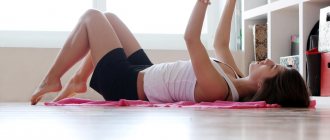If you haven't felt truly relaxed in a while, yoga can help you relax and relieve stress. Every day we immerse ourselves in work, the Internet, smartphone, etc., and all this significantly drains the energy from us.
It’s good that there are simple ways to restore it - for example, relaxing yoga poses, which are not at all complicated and are suitable even for beginners.
The interesting thing is that, despite their simplicity, these poses or asanas can help overcome stress, chronic fatigue, and disorders of the immune system - all this thanks to the good relaxation that they provide in a relatively short period of time.
By the way, such relaxation can also improve digestion (by normalizing immune function), as well as launch the internal processes of self-healing of the body.
How does yoga affect your emotional state?
To take action, you first need to understand how yoga helps calm the nervous system. To do this, it is worth considering in more detail the principle of practice point by point.
- Most of the stress a person receives accumulates in the muscles. And this is a lot of tension. This is precisely why asanas are practiced - yoga poses: by alternately straining and stretching various parts of the body, a person restores the neural circuits going from the muscle to the brain and vice versa, thus eliminating spasm.
- The practice of various balance exercises (maintaining different body positions on a small point of support) allows a person to concentrate on one process, without scattering his attention on dozens of objects at once, as happens in everyday life. Thus, the mind gradually rests, recovers and stress recedes.
- Pranayama (breathing exercises) also affects the human psyche: focusing on the breathing process and counting the necessary time periods helps a person eliminate the hustle and bustle of the mind and nervous tension.
Physical effects of asanas
There is an opinion that asanas improve health due to their specific effect on the physical body. Pressing on the insides of the body, twisting, squeezing, which do not occur in everyday life, specifically massage the internal organs. It is this type of massage that stimulates the blood and lymphatic vessels, improving the flow of nutrients and helping to remove poisons and toxins.
The beneficial effects of asanas on the endocrine system are known. Failure in the endocrine system leads to both physical disorders and mental problems. Asanas, thanks also to pressure on certain areas of the body, compression, and changes in the position of the body relative to the gravity of the earth, gradually improve the functioning of the endocrine glands.
Stretching some muscles with simultaneous compression of others, also with a change in the body in space, helps to wash both internal organs and glands with oxygenated blood, such as the thyroid gland, adrenal glands, gonads and others.
And the direct effect of asanas on the spine not only puts it in order, helping to get rid of such ailments as osteochondrosis, herniated discs, scoliosis, curvatures, but also holistically heals the entire body. Few people understand that many chronic diseases of internal organs arise precisely because of improper functioning of the spine. And by putting it in order, the functioning of organs that, it would seem, are not connected with the spinal column at all is normalized.
What breathing is used for relaxation?
Any breathing exercises to calm the nervous system of an adult are based on setting a strict rhythm. After all, it is important to understand that the effect of breathing exercises on the body depends on the strength and frequency of breaths, their depth, and the duration of breath holding. If you breathe shallowly, too often, then small portions of oxygen will enter the lungs, and the calming effect will not be achieved. Moreover, the nervous system will be stimulated, which will cause an increase in its activity.
Therefore, any breathing exercises are based on measured and deep breathing. In this case, the lungs are more fully filled with air, which leads to the enrichment of all tissues of the body with oxygen, due to which blood pressure normalizes, muscle spasms are relieved, the brain begins to work better, and the nervous system relaxes.
Stopping the mind in asanas
Of course, all this is correct and true. But it turns out that this is only a small part and not the most important positive effect of asanas on the body. We must not forget why yoga in general has a huge beneficial effect on the human psyche and body. And if you forget about this, you can either ruin the whole practice or simply harm yourself or your students.
Yoga has enormous potential and can bring benefits thousands of times greater. And we can say that when practicing yoga, using only the above-mentioned beneficial properties of asanas, the practitioner not only wastes time and does not use the full potential of yoga, but simply plays childish games without doing yoga correctly.
The greatest impact, which not only leads to health, but also corrects psychological imbalances, changes a person for the better, changes his life, gives happiness and peace of mind, lies precisely in stopping the psyche, in mental relaxation, in bringing consciousness to the silence of the mind.
By definition, yoga is the cessation of uncontrollable states of consciousness. And this principle must also be applied in asanas. Only in this case the effect from them will increase many times.
It is stopping the mind that triggers the process of self-restoration, self-healing, leading to amazing changes in the psyche and body.
In everyday activities, the body obeys us, or rather, our mind, which often does not want what the body needs. The body serves the mind, spending all its strength for this. We constantly want something, achieve certain goals, and experience all sorts of feelings and emotions. The psyche is in the mode of realizing internal aspirations and goals. All this wastes a lot of energy. During the stoppage of the mind, the realization of non-doing, we do not strive for anything, we remove our desires and aspirations. We don't have any goals.
With this regime, firstly, there is a redistribution of energy, and all the energy will now go to the body, healing it, filling it with life-giving bioenergy. And secondly, the body is finally freed from the mind and now sets its own internal, natural goals. And he has one goal: stability, restoration, maintaining homeostasis. Let me remind you that homeostasis is the ability of a system to maintain the constancy of its internal state.
That is, the body constantly strives to be healthy, but the mind prevents it from realizing this. By stopping the mind, we allow the body to do what it wants. This is how we gradually become healthy. And this is the only way we can achieve health.
And those positive impacts that were described at the beginning only help us in this.
If we perform asanas without stopping the psyche, we will get ordinary physical education with its pros and cons. Either regular body work, or overload and traumatization.
In order not to harm yourself in asanas, you need to perform them in a special state of consciousness, namely, be in the silence of the mind and listen to your body.
What to pay attention to
If you focus on stretching and relaxing the spine, you can stimulate the parasympathetic nervous system. She, in turn, is responsible for relaxing the mind and body. Therefore, for those who need to eliminate nervous tension, they should choose a sequence of poses that specifically influence this factor.
Yoga classes for relaxation and stress relief should be smooth, almost meditative in nature, which will allow a person to focus more on internal sensations and the correct positioning of the body for the necessary stretching of the spinal column.
One of the most important aspects of yoga practice for calming the nervous system is proper deep breathing, which must be controlled by focused attention. Initially, it will not always be possible to monitor the correct position of the body without being distracted by the flow of inhalation and exhalation, but as you adapt and get used to it, the process will go much better. It is also important not to rush, but to remain in each asana for at least three minutes so that the muscles can feel the pose and open more deeply.
Basic rules of practice
In the early stages of training, side effects may appear. This is caused by the fact that when performing exercises, the nerve endings touch the soft tissues and the skin itself. This circumstance occurs due to the fact that internal channels receive a large
amount of energy. Therefore, irritation, rashes, bumps, and swelling of soft tissues may appear on the skin.
If you have such symptoms, you should consult a doctor to rule out serious consequences. However, in practice it is believed that negative energy comes out through these wounds and the body is cleansed. If you continue to practice yoga, the illness will quickly pass, and small wounds will heal.
Ways to relieve stress
There are 4 types of breathing in breathing exercises:
- filling the upper parts of the lungs with oxygen when inhalations are made by movements of the collarbones;
- chest breathing, when the ribs open and contract;
- abdominal breathing using the abdominal muscles, thanks to which the diaphragm begins to move, the internal organs are massaged and oxygenated;
- a wave-like breathing method, in which the three breathing methods described above are sequentially used.
These breathing methods are basic, and on their basis other breathing techniques have been invented that are used to strengthen and calm the nerves.
Today, regardless of life stage, stress significantly affects everyone. The list of reasons for increased anxiety and fear seems endless: peer pressure, difficulties in work or in contact with peers, problems in relationships with partners; financial problems... Whatever the direct cause, stress is a factor that can have a negative impact on the functioning of the body.
Vyacheslav Smirnov is a yoga master and teacher with a higher medical education. The author of many publications, he has developed a number of programs for human health, to calm the nervous system, and to restore energy. All strengthening exercises to relieve tension are based on the best achievements of traditional yoga, psychophysiology and medicine, qigong, which help a person overcome stressful situations and relieve tension.
Vyacheslav Smirnov’s methods of relaxation and training are designed for experienced yogis, those who understand that a person is body, mind and soul, and who are able to understand what is being said, are able to sit quietly for 15-20 minutes, who are interested not only physical exercises, but also psychotechnical or energy practices.
Scientists have found a great way to relieve internal tension and relax, how to calm yourself during nervous tension.
- Sit down, close your eyes, relax and try to imagine the surface of the water, but not transparent, but white, like milk.
- Feel how you slowly sink into it, how surprisingly warm and gentle water touches your skin. Immerse yourself in it.
- Freeze for a few seconds. Give yourself over to bliss to the fullest.
- Realize that near your feet there are some holes through which the water slowly goes down, taking with it all negative emotions.
- Take a deep breath and open your eyes.
- 4 steps to breathing correctly
To calm the nervous system for healthy and sound sleep, you need to know the rules of proper breathing:
- Sit comfortably and place your hands on your stomach.
- Inhale deeply through your nose.
- Hold your breath for 3-5 minutes.
Where to begin?
For those who cannot attend the studio for a number of reasons, below is a small set of yoga asanas to relax and calm the nervous system. It will help relieve stress at home. Before performing it, you should do a short warm-up of all the main joints of the body: this can be rotation of the wrists and shoulders in different directions, as well as circular movements of the feet, hip joints and the entire pelvis in a circle.
Additionally, it is worth doing at least 12 swings of your arms in each direction: in a circle forward, then back, clapping your shoulder blades, crossing your arms over your chest, as well as small squats to stretch the knee ligaments. Afterwards, you should move on to the “downward-facing dog” pose, which is one of the basic ones in yoga and works specifically with stretching the back surface of the body, gently affecting the entire length - from the crown to the heels.
Rules for performing breathing exercises
When selecting calming breathing movements, you need to learn the most important rules for any technique, failure to comply with which will bring all your efforts down the drain:
- Any breathing exercises to calm the nervous system should be performed in a lying or standing position, in which the back is completely straight.
- It is best to do the exercises with your eyes closed, meditating and imagining pleasant pictures and images.
- You need to fully concentrate on the breathing process; at first you will have to control it consciously. Gradually, there will be a need for conscious control of inhalation and exhalation, but you will still need to concentrate on the breathing process itself.
- The mind should be freed from any negative thoughts, and all muscles should be completely relaxed. Muscle relaxation should be done smoothly - from the tips of the toes and further up the body, paying special attention to the face, neck and shoulders, where the muscles are most tense.
- Calming exercises need to be repeated 5-10 times, but do not overexert yourself. Before moving on to the next exercise, you need to wait a little so that the body has time to adapt.
- While inhaling, you need to imagine how the body, along with oxygen, is filled with calmness and pure energy. As you exhale, you need to imagine how the accumulated tension is “squeezed out” from the body.
- It is also useful during breathing exercises to repeat to yourself attitudes such as “I am calming down”, “I am calm”, “I am relaxing”, etc. Such formulations should not contain negative particles “not” and simply negative content (“I am not worried "), and forms of the future tense ("soon I will calm down").
Yoga poses to relax and relieve fatigue
The sequence of yoga exercises to calm the nervous system looks like this:
- Garudasana (those who have too tight joints in their arms and legs can use an easier option: tree pose).
Take the position as in the photo above, try to hold it for one minute or more. Then repeat on the other side.
- Uttana Padasana. Performed while standing. With your feet shoulder-width apart, bend down and try to stretch your spine in a straight line, bending your knees slightly if necessary.
- Bhujangasana is good because it controls cortisol production, so it is important to include in your arsenal, despite the fact that it activates the sympathetic nervous system. In this position, it is important not to rush, but to bend as comfortably as possible by stretching the spine, directing the chest forward and upward and helping with the shoulders, spreading them wider to the sides.
- Paschimottanasana is very similar to Uttana Padasana, but is performed in a sitting position: you need to lean forward, trying to ensure that the spinal column is well elongated. This pose is one of the best in yoga for calming the nervous system.
Sit on your heels, place your knees hip-width apart or slightly wider; let your big toes touch each other. Place a yoga cushion, a couple of pillows or a folded blanket in front of you - the whole thing should not be too soft, it should provide normal support.
Now lean forward and lie with your torso on a blanket (pillows, cushion), turn your head to the side, lower your elbows freely to the floor, palms on the floor, facing forward.
Close your eyes and try to completely relax. Stay in this position for 5 minutes, breathing freely. This is a good yoga pose to relax your back.
That blanket or pillows (what you were lying on in child’s pose) - now turn your back to them, put any support under your feet (the same pillows), cross your legs in a Turkish style, and lie with your back on the blanket.
Bring your feet together, ankles freely drop down, knees resting on the support. You can place your hands on your stomach, chest, or spread them to the sides - in general, choose any position that is comfortable for you.
Close your eyes, breathe freely and relax for 5 minutes.
So, the situation is the same: lie on your side (whichever side you want), put a pillow under your head. Next, take the same blanket on which you were lying, place it in front of you so that you can place your “upper” leg bent at the knee on it (see picture).
Place your hands as you like, close your eyes, breathe freely. Stay in this pose for 5 minutes. This is a good pose for relaxing the nervous system, and is great to do before bed; although it can be said that all these poses are good for evening practice and as a remedy for insomnia.
This pose is a real lifesaver for weak or tight hips. First you need to provide support for the front of your pelvis (a pillow or bolster will do). Place your right knee, thigh and shin on this pad and extend your entire left leg behind you. Your pelvis should receive equal support on both sides.
Place another pillow or blanket in front of you, lean forward, and place your forehead and hands on it - this will help relax your neck and shoulders.
Breathe deeply, relax your whole body for 5 minutes. Then switch legs and perform the pose again for 5 minutes. A fairly effective yoga pose for relaxing the neck.
Place a blanket or pillows on the floor (at the length of your spine), sit with your back to them, then inhale, and as you exhale, gently lie down on this support. Extend your legs forward, keeping your feet approximately hip-width apart; spread your arms slightly to the sides, or place them on your stomach or chest (you can have one hand on your heart, the other on your stomach).
Breathe deeply, trying to completely relax; feel how the chest opens, liberates, how the tension goes away. Relax your neck. Perform the pose for 5 minutes.
Shoulder stretch
Place a folded blanket on the floor and lie on your stomach. Extend your arms in opposite directions, crossing them in front of you and placing the outer sides of your forearms and palms on the floor (as in the picture).
The torso rests on a blanket support (to relieve the load from the shoulders), and the arms stretch freely in opposite directions (this can be done by lightly pressing the torso on the elbows, thereby the arms will seem to move apart to the sides).
Perform 1 minute in each direction (i.e. changing hands).
These are the simple yoga poses for relaxation and recovery. In general, they will take up to half an hour to complete; however, with practice, if you learn to relax faster, the time to complete the entire complex can be significantly reduced. By the way, this whole practice can also be considered as evening yoga for relaxation, because... it is good for relieving fatigue and stress.
You can also do not do all the poses, but only some of them that you find most effective or that you simply enjoy the most.











